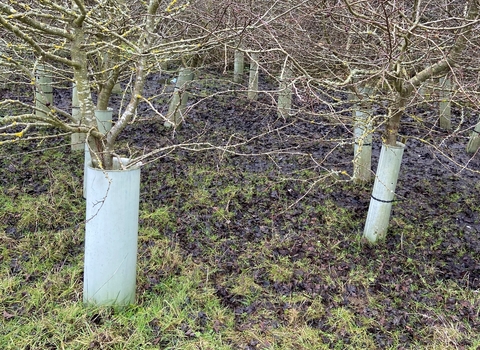Position Statement
- This position is adopted in recognition of new scientific research into plastic pollution highlighting that these practices have a potentially significant negative impact on the natural environment, both locally and globally. In the case of plastic tree guards the impact of microplastics in soils is a key concern. To eliminate future use of plastic tree guards the Trust advocates new approaches and alternative products.
- Our position here at Essex Wildlife Trust (the Trust), regarding the use of plastic tree guards and shelters, incorporates two approaches to the problem that the use of such materials poses to the natural environment. Firstly, the Trust seeks to eliminate all future use of plastic tree guards at all its sites and as soon as possible. The Trust will do this by proactively testing and trialling alternatives.
- Secondly, our position recognises that past practices have mostly relied upon using this material for effective tree protection and, therefore, working with partners, the Trust seeks the complete safe removal and, where possible, sustainable disposal and recycling where possible, of all existing plastic tree guards/shelters on Trust-owned properties. To achieve this the Trust will undertake a coordinated programme of removal and actively engage and lead on research into sustainable disposal and share this knowledge with others both inside and outside The Wildlife Trust family.
- The Trust acknowledges the likelihood of browsing pressures on young trees from browsing animals including but not limited to deer, squirrels and rabbits, and the effects of this on any planted woodland, trees and shrubs. To mitigate for this, while moving away from plastic protection, we encourage alternative protective approaches, including the use of fencing planting sites or utilising more natural tree protection, such as using other vegetation as a browsing deterrent, like brash, and natural boundary protection, such as dead hedging.
- In addition, where tree guards are deemed essential or more cost-effective for the success of a planting project, we will proactively pursue the use of non-plastic, more naturalistic material tree guards, which are available for individual sapling protection. Environmental impacts (e.g., carbon foot printing) from manufacturing and product end of life planning, will be considered for all tree guards used, dependant on their materials and sustainability ethics.
- Long term, we support the notion of more nature-based solutions for increasing tree cover in Essex, such as natural regeneration and re-wilding.
- This baseline position will be upheld within the Trust whilst we build on a more coordinated internal strategy moving forward to unify departments within the organisation on the working procedures of using tree guards, regarding the purchasing, removal, and disposal of these tree planting tools.
- Continuous development and learning will foresee likely changes required in policy and working procedures around this Position Statement, where the Trust’s position will be regularly reviewed as the scientific research and knowledge of the sustainability of different approaches progresses.
Definition
- Plastic tree guards – A tree shelter, tree guard or tree tube made from plastic that is designed to protect planted tree saplings from browsing animals, bad weather and damage, to maximise their success.
- Plastic pollution- The accumulation of plastic objects and particles that adversely effects the environment and wildlife.
- Sustainability – avoidance of the depletion of natural resources in order to maintain an ecological balance.
- Re-wilding – restore an area of land back to a natural, uncultivated state, aimed to restore and protect natural processes.
- Natural regeneration – re-grow, re-new, re-store.

